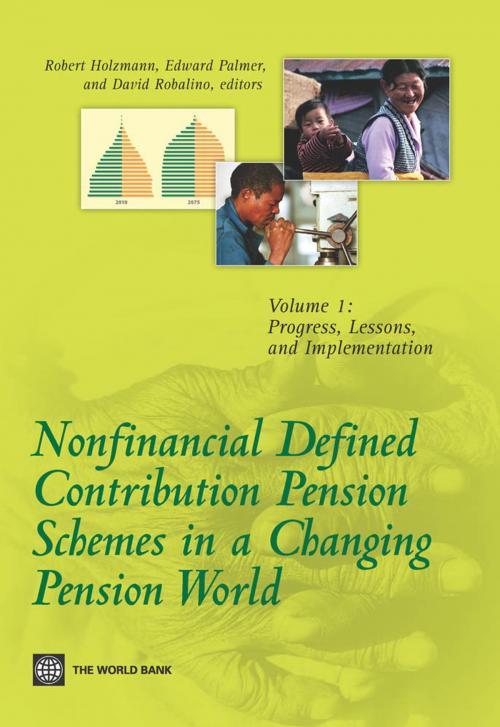Nonfinancial Defined Contribution Pension Schemes in a Changing Pension World
Volume 1, Progress, Lessons, and Implementation
Business & Finance, Industries & Professions, Insurance, Career Planning & Job Hunting, Labor, Personal Finance, Retirement Planning| Author: | ISBN: | 9780821388525 | |
| Publisher: | World Bank Publications | Publication: | June 21, 2012 |
| Imprint: | World Bank Publications | Language: | English |
| Author: | |
| ISBN: | 9780821388525 |
| Publisher: | World Bank Publications |
| Publication: | June 21, 2012 |
| Imprint: | World Bank Publications |
| Language: | English |
Nonfinancial Defined Contribution (NDC) schemes are now in their teens. The new pension concept was born in the early 1990s, implemented from the mid-1990s in Italy, Latvia, Poland and Sweden, legislated most recently in Norway and Egypt and serves as inspiration for other reform countries. This innovative unfunded individual account scheme created high hopes at a time when the world seemed to have been locked into a stalemate between piecemeal reforms of ailing traditional defined benefit schemes and introducing pre-funded financial account schemes. The experiences and conceptual issues of NDC in its childhood were reviewed in a prior anthology (Holzmann and Palmer, 2006). This new anthology published in 2 volumes serves to review its adolescence and with the aim of contributing to a successful adulthood. Volume 1 on Lessons, Issues, Implementation includes a detailed analysis of the experience and the key policy lessons in the old and new pilot countries and general thoughts around the implementation of NDCs in other countries, including Chile, Greece and China. Volume 2 on Gender, Politics, Financial Stability includes deeper and new analyses of these issues that found limited or no attention in the 2006 publication. The key policy conclusions include: (i) NDC schemes work well (as documented by the experience of Italy, Latvia, Poland and Sweden during the crisis) but there is room to make them work even better; (ii) Go for an immediate transition to the new scheme to avoid future problems; (iii) Identify the legacy costs and their explicit financing during the transition as they will hit you otherwise soon; (iv) Adopt an explicit stabilizing mechanism to guarantee solvency; (v) Establish a reserve fund to guarantee liquidity; (vi) Elaborate an explicit mechanism to share the systemic longevity risk; and, last but not least; (vii) Address the gender implications of NDC with deeper analysis and open political discourse.
Nonfinancial Defined Contribution (NDC) schemes are now in their teens. The new pension concept was born in the early 1990s, implemented from the mid-1990s in Italy, Latvia, Poland and Sweden, legislated most recently in Norway and Egypt and serves as inspiration for other reform countries. This innovative unfunded individual account scheme created high hopes at a time when the world seemed to have been locked into a stalemate between piecemeal reforms of ailing traditional defined benefit schemes and introducing pre-funded financial account schemes. The experiences and conceptual issues of NDC in its childhood were reviewed in a prior anthology (Holzmann and Palmer, 2006). This new anthology published in 2 volumes serves to review its adolescence and with the aim of contributing to a successful adulthood. Volume 1 on Lessons, Issues, Implementation includes a detailed analysis of the experience and the key policy lessons in the old and new pilot countries and general thoughts around the implementation of NDCs in other countries, including Chile, Greece and China. Volume 2 on Gender, Politics, Financial Stability includes deeper and new analyses of these issues that found limited or no attention in the 2006 publication. The key policy conclusions include: (i) NDC schemes work well (as documented by the experience of Italy, Latvia, Poland and Sweden during the crisis) but there is room to make them work even better; (ii) Go for an immediate transition to the new scheme to avoid future problems; (iii) Identify the legacy costs and their explicit financing during the transition as they will hit you otherwise soon; (iv) Adopt an explicit stabilizing mechanism to guarantee solvency; (v) Establish a reserve fund to guarantee liquidity; (vi) Elaborate an explicit mechanism to share the systemic longevity risk; and, last but not least; (vii) Address the gender implications of NDC with deeper analysis and open political discourse.















